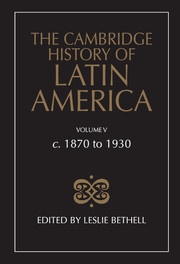Book contents
- Frontmatter
- PART ONE MEXICO
- PART TWO CENTRAL AMERICA AND THE CARIBBEAN
- 4 Central America: the Liberal era, c. 1870–1930
- 5 Cuba, c. 1860–1934
- 6 Puerto Rico, c. 1870–1940
- 7 The Dominican Republic, c. 1870–1930
- 8 Haiti, c. 1870–1930
- PART THREE THE RIVER PLATE REPUBLICS
- PART FOUR THE ANDEAN REPUBLICSo
- PART FIVE BRAZIL
- Bibliographical essays
- References
4 - Central America: the Liberal era, c. 1870–1930
from PART TWO - CENTRAL AMERICA AND THE CARIBBEAN
Published online by Cambridge University Press: 28 March 2008
- Frontmatter
- PART ONE MEXICO
- PART TWO CENTRAL AMERICA AND THE CARIBBEAN
- 4 Central America: the Liberal era, c. 1870–1930
- 5 Cuba, c. 1860–1934
- 6 Puerto Rico, c. 1870–1940
- 7 The Dominican Republic, c. 1870–1930
- 8 Haiti, c. 1870–1930
- PART THREE THE RIVER PLATE REPUBLICS
- PART FOUR THE ANDEAN REPUBLICSo
- PART FIVE BRAZIL
- Bibliographical essays
- References
Summary
The six decades from 1870 to 1930 witnessed the somewhat late full integration of Central America into the capitalist world market through the expansion of its export economies. They also saw the formation of several relatively viable states and, therefore, the strengthening of the division of the United Provinces of Central America established after independence into five republics, even though there were some attempts to restore the lost union. Central American scholars were, and still are inclined to see the history of the isthmus (with the exception of Panama, which only became an independent state in 1903) as a unity. They preserved a somewhat vague, even romantic aspiration that the five patrias chicas (‘small homelands’) should eventually merge again in a patria grande (that is to say, a united Central America). Up to a point, there are grounds for such an ambition. In this period, for instance, some of the central features of economic life - for example, the production and export of coffee and bananas - were shared by most Central American countries; as, in politics, they shared the upheavals of Liberal reforms and then the hardships of Liberal dictatorships, as well as a common and very strong dependence on the United States. But much more striking in such a small region are the strong differences which existed between the five Republics. In this chapter we shall frequently be contrasting the evolution of Costa Rica with that of the other countries in the isthmus. Costa Rica, Guatemala and El Salvador, from 1870 to 1930, may be seen as more advanced countries economically and politically than Honduras and, to a lesser degree, Nicaragua.
- Type
- Chapter
- Information
- The Cambridge History of Latin America , pp. 195 - 228Publisher: Cambridge University PressPrint publication year: 1986
References
- 1
- Cited by



